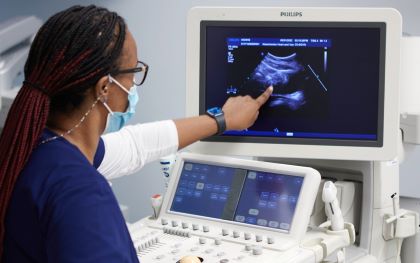
Diagnostic medical sonographers (Ultrasound Techs) operate special imaging equipment that uses high-frequency sound waves to create images of the interior of the human body. The images and test results help physicians assess and diagnose medical conditions. In fact, ultrasound sonograms are often the first imaging tests performed when disease is suspected.
The sonographer uses an instrument called an ultrasound transducer to scan parts of the patient's body that are being examined. The transducer emits pulses of sound that bounce back, causing echoes. The echoes are then sent to an ultrasound machine, which processes them and displays them as images used by physicians for diagnosis.
Cardiac sonographers (echocardiographers) specialize in imaging a patient's heart. They use ultrasound equipment to examine the heart's chambers, valves, and vessels. The images obtained are known as echocardiograms. An echocardiogram may be performed either while the patient is resting or after the patient has been physically active. Cardiac sonographers also may take echocardiograms of fetal hearts so that physicians can diagnose cardiac conditions during pregnancy. Cardiac sonographers work closely with physicians or surgeons before, during, and after procedures.
Pediatric sonographers specialize in imaging children and infants. Many of the medical conditions they image are associated with premature births or birth defects. Pediatric sonographers may work closely with pediatricians and other caregivers. Musculoskeletal sonographers specialize in imaging muscles, ligaments, tendons, and joints. These sonographers may assist with ultrasound guidance for injections, or during surgical procedures, that deliver medication or treatment directly to affected tissues.
Obstetric and gynecologic sonographers specialize in imaging the female reproductive system. Many pregnant women receive sonograms to track the baby's growth and health. Obstetrical sonographers work closely with physicians in detecting congenital birth defects. Sonography can confirm the presence of cysts and tumors that may have been detected by the patient, the physician, or a mammogram.
Diagnostic medical sonographers need formal education, such as an associate's degree or a postsecondary certificate. Employers prefer graduates of programs accredited by the Commission on Accreditation of Allied Health Education Programs (CAAHEP). Colleges and universities offer both associate's and bachelor's degree programs in sonography, while one-year certificate programs may be available from selected hospitals.
Sonographic Imaging Techniques focuses on developing the practical skills needed to perform ultrasound scans effectively. Students learn various imaging techniques, such as abdominal, obstetric, gynecological, vascular, and echocardiographic examinations. Emphasis is placed on proper scanning protocols, patient positioning, and image optimization.
Hands-on clinical Clinical Internship: experience is essential for ultrasound students to apply theoretical knowledge in real-world settings. Under the supervision of experienced sonographers and physicians, students practice scanning techniques, interact with patients, and participate in the diagnostic process.
The ARDMS offers ultrasound certificates in Abdomen, Breast, Echocardiography, Neurosonology, OB/GYN, Vascular Technology, Musculoskeletal Sonography. The Commission on Accreditation of Allied Health Education Programs (CAAHEP) accredits thousands of health science education programs in the US. If you graduate from a school accredited by the CAAHEP, you’re automatically qualified to sit for the ARDMS exam. In order to earn certification from the ARDMS, individuals must take the Sonography Principles & Instrumentation (SPI) examination.
The ARDMS (American Registry for Diagnostic Medical Sonographers), formed under Inteleos, is a non-profit organization established in 1975. Worldwide, over 90,000 medical professionals have been certified by the ARDMS, representing a variety of specializations including cardiac, vascular, and OB/GYN sonography. ARDMS is accredited by several prestigious and reputable bodies, including the International Organization for Standardization (ISO), National Commission for Certifying Agencies (NCCA) and the American National Standards Institute (ANSI).
-Hepatitis A: transmitted fecal-oral in contaminated food or water, vaccine is available, anti-HAV IgM or IgG to diagnose, post-exposure: immune globulin (2 weeks after exposure), acute only
-Hepatitis B: transmitted via blood and body fluids...most commonly sexual intercourse and IV drug use, HBsAg (infectious) and anti-HAV (immune), vaccine available, acute and chronic
-Hepatitis C: transmitted via blood and body fluids...most commonly IV drug use, NO vaccine available, acute and chronic
In this video we will discuss sympathetic and parasympathetic pharmacology, which will include a discussion about sympathomimetics, parasympathomimetics, sympatholytics, and parasympatholytics drugs.
Bone fracture types nursing review for the NCLEX exam that covers treatments, signs and symptoms, causes, and nursing interventions. A bone fracture is a break or crack in a bone. There are several types of bone fractures.
-Fluid and electrolyte normal values range balance
-Signs and symptoms of fluid and electrolyte imbalances
-Causes of fluid and electrolyte imbalances
-Fluid and electrolytes mnemonics (memorization tricks)
-Includes all 6 fluid and electrolytes (calcium, magnesium, phosphate, potassium, sodium, and chloride)
Ask yourself if you can see yourself being an ultrasound tech, having daily contact with patients who may be elderly, ill, or recovering from surgery. Other patients may have physical or emotional disabilities, which can be challenging. While classes and internships will prepare you well, certain innate qualities that you bring to bear will help you succeed.
Attending college offers benefits beyond academic learning. Students are exposed to diverse perspectives that challenge their thinking. This fosters problem-solving and communication. College is also about social skills. Whether through student organizations or sports teams, students develop leadership skills and build lasting friendships.
This website is not affiliated with any educational institution, and all trademarks are the exclusive property of the respective owners. All copyrighted works on this website are offered for educational purposes only, governed by the four-factor rule, section 107 of the Copyright Act. CampusInspector.com is the work of a group of students in Bangkok, using data from the US Department of Education, Postsecondary Education Data System (IPEDS). If any information is incorrect, please contact us with updates.